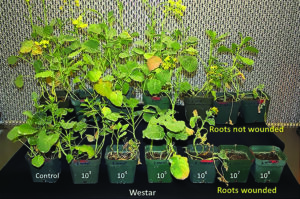Seed treatments protect susceptible cultivars from blackleg
KEY RESULT:
Fluopyram, Saltro and Bion seed treatments look promising against early blackleg infection, however none of these seed treatments has shown significant additional efficacy on any of the resistant canola cultivars tested under field conditions.
PROJECT TITLE, PRINCIPAL INVESTIGATOR:
“Exploring novel seed-treatment options to mitigate the impact of blackleg on canola,” Gary Peng, AAFC Saskatoon
FUNDING:
PUBLISHED ARTICLES:
Peng G, Liu X, McLaren D, McGregor L, Yu F. 2020. “Fungicide seed treatment for effective control of blackleg of canola in Canada.” Can J. Plant Path. 42: 480-492.
The fungus Leptosphaeria maculans is the primary cause of blackleg, and L. maculans inoculum over 10,000 spores per gram of soil can also result in severe blackleg via root infection, especially if roots are wounded (by root maggots, for example). Fluopyram, Saltro and Bion seed treatments show promise to protect susceptible cultivars against the early blackleg infection, either through roots or from cotyledon and leaf wounds.
Study objectives were to 1) understand the soil inoculum level of blackleg pathogen required to cause root infection, which would lead to severe blackleg, 2) evaluate new commercial products for potential seed treatment against the early blackleg infection, 3) assess the rate effect of top candidates for maximum efficacy, and 4) validate the efficacy in multiple field trials.
Researchers used greenhouse studies for the first three objectives. Blackleg pathogen inoculum was applied as a soil drench at zero to 100 million spores per gram of soil to cause infection via roots. Roots of certain plants were wounded by cutting to simulate soil insect damage. About a dozen of new seed-treatment candidates were evaluated for restricting infection on cotyledons, and promising candidates were assessed further for control of root infection. Top candidates were also tested in field trials (objective 4) by targeted inoculation either on different leaves or via roots (soil drench inoculation).
The drought of 2021 and early dry conditions in Saskatoon in 2022 hampered field trials. Many inoculated leaves had dropped before the pathogen was able to spread into the stem, so the disease levels were much lower than other years, despite the inoculation applied.
Result showed that L. maculans inoculum at 1,000 to 10,000 pycnidiospores per gram of soil can cause root infection which ultimately results in severe blackleg. While current seed treatments Helix and Prosper are ineffective against blackleg infection from lower leaves or roots, new products Fluopyram, Saltro and Bion appear promising against early blackleg infection. However, more field work is required for robust data. The Fluopyram treatment at 75g/100kg seed (registered rate) showed stability in efficacy with delayed emergence under controlled environment, but failed to control blackleg significantly in these field trials, a circumstance partially attributable to the weather conditions experience. Increasing the product rate to 300g achieved significant efficacy against root infection. The Bion seed treatment reduced the blackleg severity via the cotyledon (but not first-leaf inoculation) on the susceptible cultivar Westar only. Efficacy of seed treatment may be improved by increasing the rate of treatment, which warrants further investigation.
None of the seed treatments evaluated showed efficacy against blackleg on resistant canola cultivars, on which the disease severity index was generally very low (<10 per cent) already in all these trials. However, due to the relatively low cost, a seed treatment may still be a good insurance policy in case of resistance erosion.






